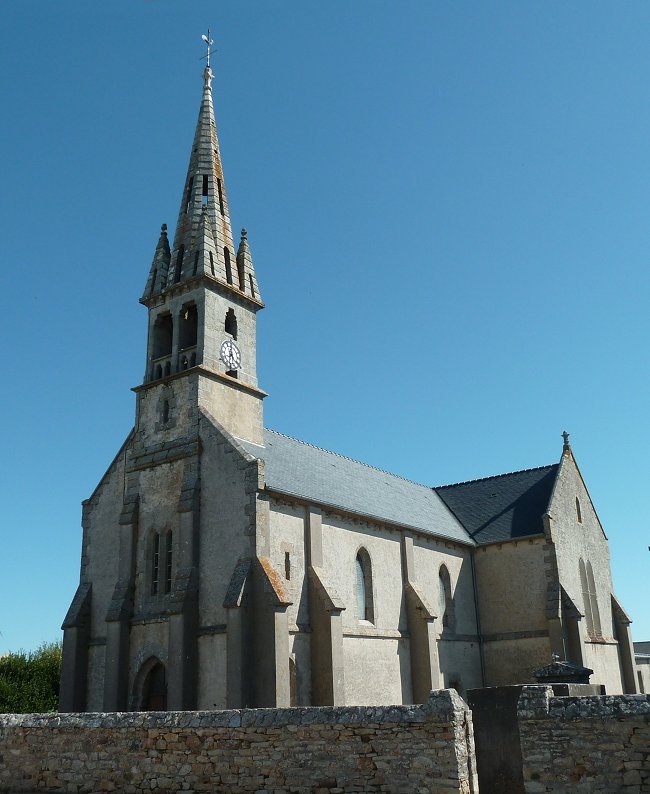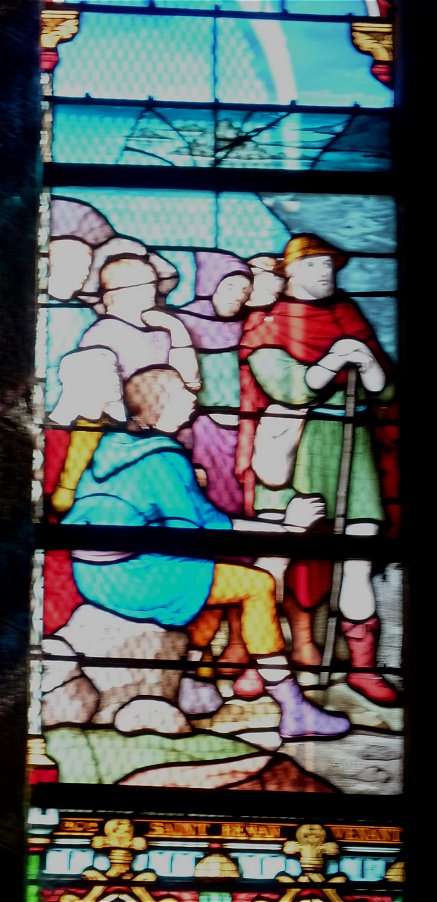St-Ronan Church
at Molène Island
( Municipality of Molène-Island )

GPS : 48°23'48 N 4°57'21 W

Access :
The church is located at the top of the village of Molène.
This building is part of a complex that also includes the communal cemetery and the war memorial. Its integrated bell tower has a bell chamber with a balustrade and an openwork octagonal spire surrounded by four openwork pyramidal pinnacles.

It was built between 1878 and 1882 by the architect Ernest Le Guerrannic, who erected or restored several other religious buildings in the Iroise Country. Replacing an old chapel repaired in 1776 and dedicated to the Virgin Mary, it was officially consecrated on 18 July 1881. It is dedicated to Saint Ronan and its plan has the shape of a Latin cross.

Document available to visitors.
If you can't read this document, you may be able to listen to a summary of it : plug in the sound and find here the summary on the Voix du Patrimoine website.
According to tradition, at the beginning of the 6th century, coming from Ireland, Saint Ronan disembarked as a hermit in Molène, where he made a spring gush out near the port. Then he settled in St-Renan. Then he went to Locronan, Cornouaille, where he is said to have performed several miracles and where the church houses his grave.
Saint Nicholas, Christ in the Sacred Heart, Saint Anne and her daughter Mary.
The polychrome wooden statue of Saint Nicholas dates from the 18th century.
The walls are decorated with stations of the Stations of the Cross.

An original painting in relief is exhibited in memory of Olivier Raoux (1961-2011), the famous chief-decorator of cinema, who died on the island during the shooting of the film "Les Seigneurs" by Olivier Dahan.

And next to it, a plaque commemorates the 1896 sinking of the English liner Drummond Castle.

You can also visit the small museum dedicated to him on the island :
Musée du Drummond-Castle.
Two ex-votos hang from the transept vault. These models both commemorate the wishes of sailors who have survived a shipwreck.


In the north wing of the transept, a secure display case containing liturgical goldsmiths' items and a painting attract attention.


The painting of the Virgin and Child is a very beautiful oil on canvas, work of a French school of the 17th century.
Among goldsmith's items dating back to the same period, the gilt chalice enriched with precious stones and the paten offered to the inhabitants by the English Catholics following the sinking of the Drummond Castle are particularly noteworthy.

The double stained glass window overlooking the display dates from 1928.

The baptismal font is located in the corner of this transept.

Under the cross of the choir is a polychrome wooden reliquary from the 18th century. The altar, very sober, is made of granite.

It is illuminated by a triple stained glass window made in 1904 and representing Saint Ronan and his retinue landing on the island of Molène among an admiring population.


A copy of this Saint Ronan can be seen in the Harbour
on the wall of the old lifeboat shelter.

|

|
Two 17th century statues in polychrome wood frame the choir. On the left, Saint Ronan. On the right, a Virgin and Child, called Our Lady of Graces, comes from the town of The Relecq-Kerhuon.

|

|
On either side of the choir, stalls still bear witness to the past presence of the monks of St-Mathieu Abbey in the former chapel during certain ceremonies.

And in a corner of the south transept, dedicated to the Virgin Mary, one will finally notice the double confessional.

READ MORE
Interesting excerpts from archival documents can be read on the Info Bretagne website. Info Bretagne




